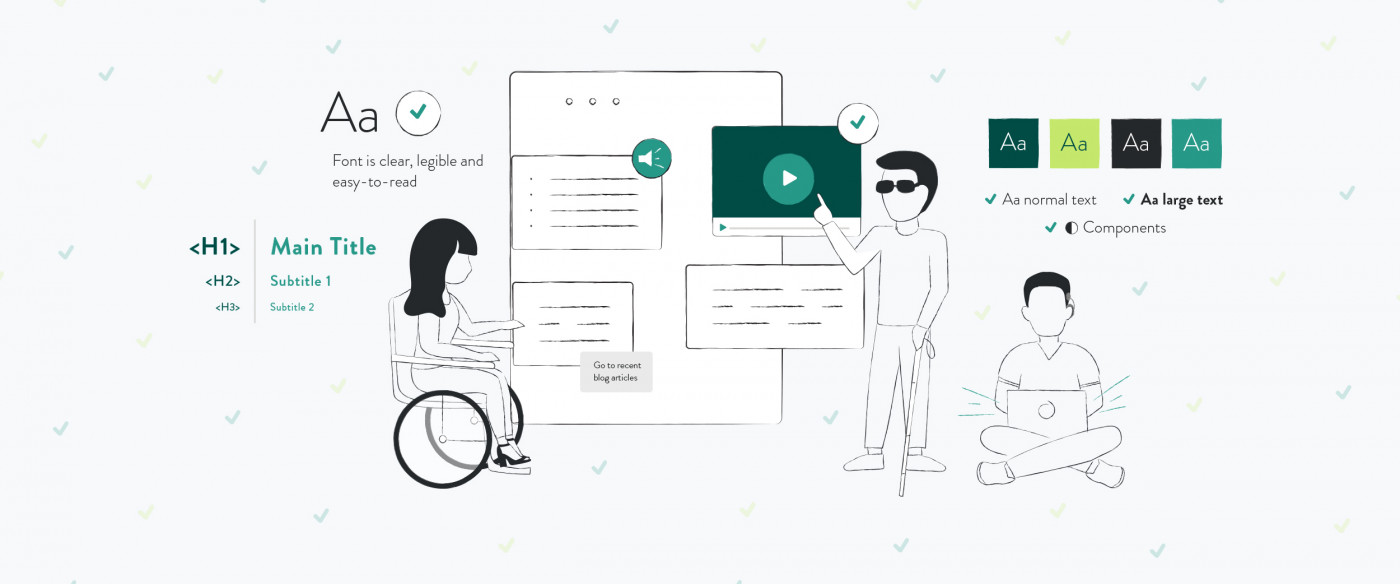As a member of the digital business world, you may have heard the term “ADA compliance,” but do you really understand what it means? Do you know how it impacts you? Are you uncertain as to how to begin the process of making your website more accessible?
Guaranteeing equal access to online content has become an increasingly hot topic throughout recent years. Efforts towards this end have been gaining traction. However, the gray area surrounding the issue can make it difficult to understand what the rules are and to whom they apply.
When running a business with an online presence in the 21st century, it is essential to remain aware of the most recent developments regarding the issue. An understanding of what ADA compliance entails, why it matters, and how to engage in best practices will provide a company with a major advantage.

What Is ADA Compliance?
What the ADA Means for Businesses
ADA stands for the Americans with Disabilities Act. Established in the 1990s, its goal was to ensure equal opportunity for those experiencing disabilities as defined by the act. Title III particularly applies to businesses, stating that public accommodations must allow for equal access on the part of those with disabilities. When it comes to physical storefronts, the rules are more clearly defined and therefore easier to follow. In the online arena, however, the requirements are a bit more open to interpretation.
Several decades ago, when the ADA was first established, technology played a much less significant role in daily life than it currently does. The internet’s full potential had not yet been realized, and therefore, the standards the ADA sets forth focus more on real-world interaction. Due to this, whether the ADA imposes any true requirements upon websites is primarily up to the interpretation of the courts.
What ADA Means for Company Websites
Unfortunately, court opinions related to the ADA can vary widely. However, the tide has turned, primarily in favor of those with disabilities. Throughout recent years, many complaints have been filed against businesses for poor web accessibility practices, citing the ADA as their legal basis. These cases are taken quite seriously, and some have been decided in favor of those filing suit. In particular, large businesses that make a great deal of money have come under attack - far more so than smaller or mid-sized companies.
WCAG, the Standard for Web Accessibility
When it comes to web accessibility and ADA compliance, the most widely-recognized standard is the World Wide Web Consortium’s Web Content Accessibility Guidelines (WCAG).
The World Wide Web Consortium's Web Content Accessibility Guidelines are comprised of several different levels. Level A addresses the most urgent issues that prevent those with disabilities from engaging with a website. Level AA is the standard most businesses strive to reach. Level AAA is the most intense, and may not be attainable for the average company, particularly if its website includes certain types of content. Version 2.0 of the WCAG is the most generally recognized, though further updates did come out in spring of 2018, resulting in a 2.1 version.
WCAG’s 4 Main Principles
To remember the WCAG’s four main principles, keep the acronym POUR in mind - preceivable, operable, understandable, and robust.
Perceivability refers to ensuring that anyone can take in a site’s content. Operability consists of the ease with which a site can be operated. Understandability has to do with producing content that can be easily understood by the viewer. Robust means that a site will remain accessible throughout future technological advances. Sites that incorporate these 4 principles will automatically become far more accessible and user-friendly!

Why You Should Prioritize ADA Compliance
Why is it so important to prioritize increasing the accessibility of your website? With all of the other business concerns clamoring for your attention, why should you focus in on ADA compliance? Doing so is of extreme importance for the following reasons.
It Is a Relevant Issue.
Equal access to web content has become an established issue. ADA compliance is receiving an ever-increasing amount of attention, in much the same way as the issues surrounding the Civil Rights Act did years ago. Thus, it would behoove the modern business to stay ahead of the curve by giving the matter serious consideration.
Corporate Social Responsibility Matters.
In modern culture, corporate social responsibility has gained traction. Consumers desire for corporations to take a stand regarding social issues and use their platforms to do something about them. Thus, while taking steps to make your website more accessible may involve some expense, it is a worthwhile investment as doing so will position you as a brand that cares. It will project an image of integrity - a rare commodity in today’s world - which will increase your audience and attract customers.
It Allows You to Widen Your Customer Base.
Prioritizing ADA compliance will also allow you to expand your customer base by making your business accessible to a wider range of individuals. Many people deal with some type of limitation - whether temporary or permanent - most likely including some of your target audience members. Thus, ensuring that your website is accessible to as wide a range of consumers as possible increases your chances for a greater volume of business!
Accessibility Standards = Best Web Practices
Many accessibility standards are actually general best web practices anyways. As such, they can help greatly with search engine optimization, and can also improve your website’s general user experience. It is therefore to your advantage to strive towards accessibility within your website.
How to Take Steps Towards ADA Compliance
Though currently somewhat vague, the rules regarding ADA compliance for websites are likely to become far less so in the years ahead. What was once gray area will likely become black and white at a rapid rate. After all, an increasing number of cases related to the issue have already begun to pop up, requiring courts to sort through the specifics of the ADA’s relationship with websites. Therefore, following widely-accepted standards such as the World Wide Web Consortium’s Web Content Accessibility Guidelines is a smart move on the part of any modern business with an online presence.
Want to make your website more accessible, but aren’t sure where to start? Check out this web accessibility checklist! Even simple steps, such as including quality alternative text descriptions for your visuals and using contrasting colors, can go a long way.
At Dynamic, our preferred way to increase the accessibility of a business website is to create the site in the SilverStripe CMS. SilverStripe is a flexible, user-friendly content management system that supports individuals and organizations in developing accessible websites. SilverStripe keeps web accessibility guidelines top of mind, and as such, includes the features its users need to create ADA compliant websites. Using SilverStripe is an easy way to put yourself at the forefront when it comes to ADA compliance!
As you begin to take strides towards ADA compliance, remember to continually assess your progress. After all, web accessibility is an ongoing rather than a one-time project. It represents a lifelong learning curve, but the measurement of true success is continual improvement!


